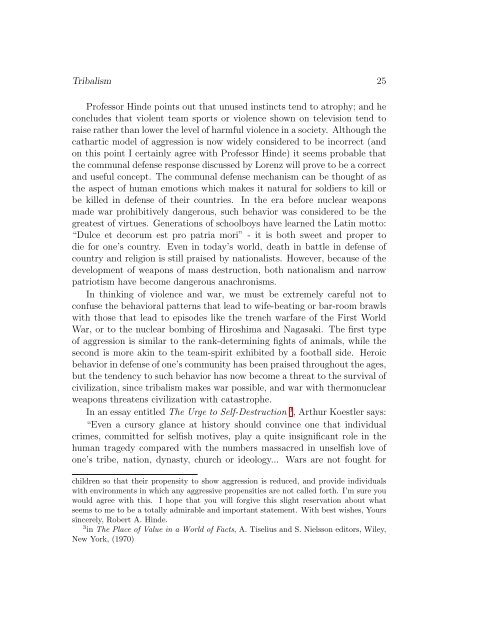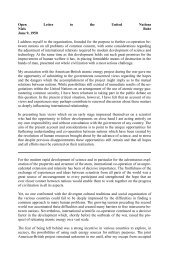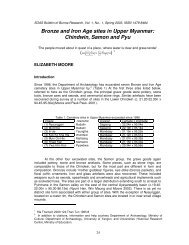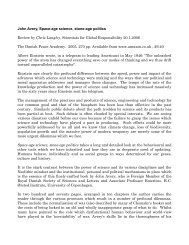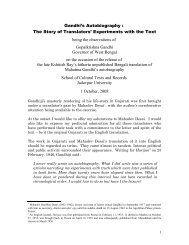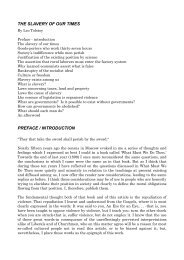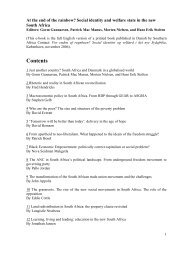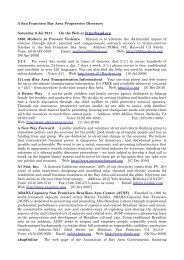Space-Age Science and Stone-Age Politics - Learning Development ...
Space-Age Science and Stone-Age Politics - Learning Development ...
Space-Age Science and Stone-Age Politics - Learning Development ...
Create successful ePaper yourself
Turn your PDF publications into a flip-book with our unique Google optimized e-Paper software.
Tribalism 25<br />
Professor Hinde points out that unused instincts tend to atrophy; <strong>and</strong> he<br />
concludes that violent team sports or violence shown on television tend to<br />
raise rather than lower the level of harmful violence in a society. Although the<br />
cathartic model of aggression is now widely considered to be incorrect (<strong>and</strong><br />
on this point I certainly agree with Professor Hinde) it seems probable that<br />
the communal defense response discussed by Lorenz will prove to be a correct<br />
<strong>and</strong> useful concept. The communal defense mechanism can be thought of as<br />
the aspect of human emotions which makes it natural for soldiers to kill or<br />
be killed in defense of their countries. In the era before nuclear weapons<br />
made war prohibitively dangerous, such behavior was considered to be the<br />
greatest of virtues. Generations of schoolboys have learned the Latin motto:<br />
“Dulce et decorum est pro patria mori” - it is both sweet <strong>and</strong> proper to<br />
die for one’s country. Even in today’s world, death in battle in defense of<br />
country <strong>and</strong> religion is still praised by nationalists. However, because of the<br />
development of weapons of mass destruction, both nationalism <strong>and</strong> narrow<br />
patriotism have become dangerous anachronisms.<br />
In thinking of violence <strong>and</strong> war, we must be extremely careful not to<br />
confuse the behavioral patterns that lead to wife-beating or bar-room brawls<br />
with those that lead to episodes like the trench warfare of the First World<br />
War, or to the nuclear bombing of Hiroshima <strong>and</strong> Nagasaki. The first type<br />
of aggression is similar to the rank-determining fights of animals, while the<br />
second is more akin to the team-spirit exhibited by a football side. Heroic<br />
behavior in defense of one’s community has been praised throughout the ages,<br />
but the tendency to such behavior has now become a threat to the survival of<br />
civilization, since tribalism makes war possible, <strong>and</strong> war with thermonuclear<br />
weapons threatens civilization with catastrophe.<br />
In an essay entitled The Urge to Self-Destruction 3 , Arthur Koestler says:<br />
“Even a cursory glance at history should convince one that individual<br />
crimes, committed for selfish motives, play a quite insignificant role in the<br />
human tragedy compared with the numbers massacred in unselfish love of<br />
one’s tribe, nation, dynasty, church or ideology... Wars are not fought for<br />
children so that their propensity to show aggression is reduced, <strong>and</strong> provide individuals<br />
with environments in which any aggressive propensities are not called forth. I’m sure you<br />
would agree with this. I hope that you will forgive this slight reservation about what<br />
seems to me to be a totally admirable <strong>and</strong> important statement. With best wishes, Yours<br />
sincerely, Robert A. Hinde.<br />
3 in The Place of Value in a World of Facts, A. Tiselius <strong>and</strong> S. Nielsson editors, Wiley,<br />
New York, (1970)


